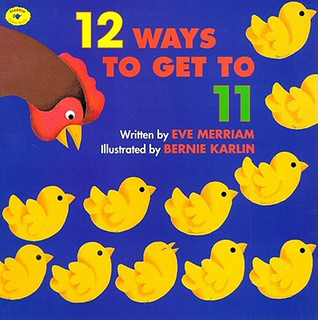 by Eve Merriam
by Eve Merriam
Is it in the magician’s hat? Maybe it’s in the mailbox or hiding in the jack-o’-lantern? Don’t forget to look in the barnyard where the hen awaits the arrival of her new little chicks. Could that be where eleven went? Eve Merriam and Bernie Karlin take young readers on a counting adventure as they demonstrate twelve witty and imaginative ways to get to eleven.
Strategies/Skills Used
Reading Strategy 1: Access background information.
Reading Strategy 2: Predict what will be learned or what will happen.
Reading Strategy 4: Self-monitor and self-correct.
Reading Strategy 5: Make mental pictures.
Reading Strategy 6: Connect what you read with what you already know.
Reading Strategy 8: Extract information from text, charts, graphs, maps and illustrations.
Reading Strategy 11: Make inferences and draw conclusions.
Writing Skill 2: I organize my ideas based on my purpose for writing.
Writing Skill 4: I write so my thoughts flow smoothly and are easy to read.
Writing Skill 7: I use my personal style to make my writing unique.
 TEACHING THE ACTIVITY: PRE-READING
TEACHING THE ACTIVITY: PRE-READING
(1) Model the reading strategy Question and Revise for your students, using the book cover as the image driving your discussion.
(2) Ask students to participate and contribute ideas as you lead them through the activity.
(3) Select three pages in the book, one from the beginning, one from the middle of the book and one from the end. Show students the first illustration.
(4) Have students discuss the illustration in a small group, answering the questions in the Question and Revise strategy.
(5) Repeat this process with the next two illustrations, adding information to what they already know from the first illustration. Have students discuss their predictions about the storyline and how this process enhances their thinking.
 TEACHING THE ACTIVITY: DURING READING
TEACHING THE ACTIVITY: DURING READING
(6) Divide the story 12 Ways to Get to 11 into three logical parts to read aloud to the class using the Read-Draw-Confirm framework.
(7) Fold an 11 x 17 piece of paper into three sections for each student to record their work on.
(8) Prompt students to make mental pictures as the first part of the story is read aloud to them and to draw an accurate, detailed picture of the passage, adding captions or sentences. Allow sufficient time to complete this task before continuing to read the story. Repeat this process with all three parts of the story.
(9) Encourage students to connect to what they know about how to count or organize objects, and what is being represented in the story, in order to create detailed illustrations.
(10) After the drawing time has elapsed, re-read the story to the class. Ask students to see if their drawings are accurate. Provide students with the opportunity to make any changes they feel are appropriate. Have students share their three representations of the story in small groups and discuss the big ideas of the story.
 TEACHING THE ACTIVITY: POST-READING
TEACHING THE ACTIVITY: POST-READING
(11) Ask students to create an acrostic poem highlighting the main ideas of the story 12 ways to get 11, using the words eleven and/or twelve. See Poetry With a Purpose: Acrostic Poems.
(12) Encourage students to use characters and objects from the book.
(13) Have students refer to their previous drawings for ideas for the acrostic poem.
(14) Ask students to share poems with partners, small groups or the whole class.